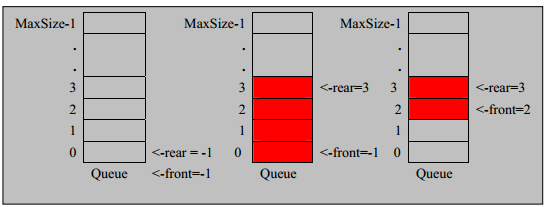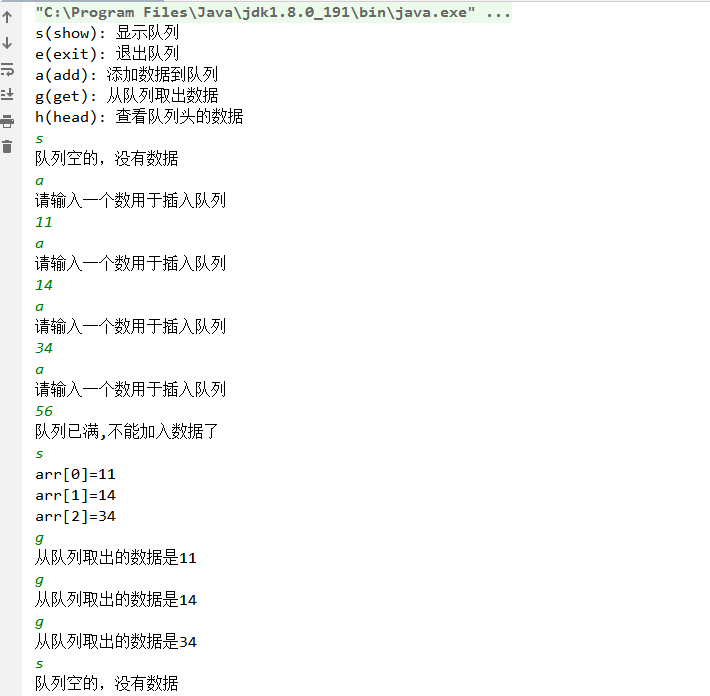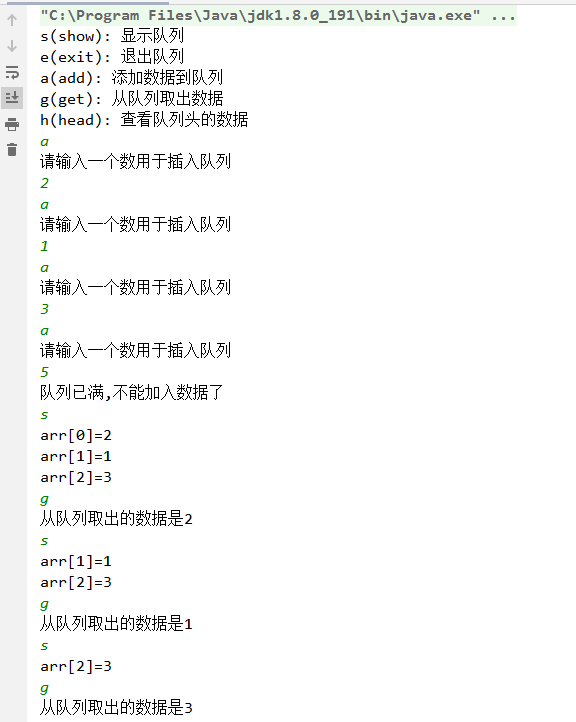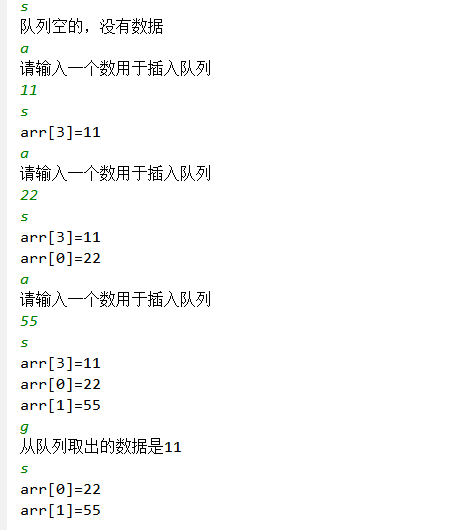1. 简介
队列是一个有序列表,可以用数组或是链表来实现。
遵循先入先出的原则。即:先存入队列的数据,要先取出。后存入的要后取出
示意图:(使用数组模拟队列示意图)

2. 数组模拟队列
实现思路
队列本身是有序列表,若使用数组的结构来存储队列的数据,则队列数组的声明如下图, 其中 maxSize 是该队列的最大容量。
因为队列的输出、输入是分别从前后端来处理,因此需要两个变量 front及 rear分别记录队列前后端的下标,front 会随着数据输出而改变,而 rear则是随着数据输入而改变,如图所示:

当我们将数据存入队列时称为addQueue,addQueue 的处理需要有两个步骤:思路分析
将尾指针往后移:rear+1 , 当front == rear【空】
若尾指针 rear 小于队列的最大下标 maxSize-1,则将数据存入 rear所指的数组元素中,否则无法存入数据。 rear == maxSize - 1[队列满]
具体代码如下
队列代码
package com.queue;
/**
* 使用数组模拟队列
*
* @author john
* @date 2019/12/17 - 17:49
*/
class ArrayQueue {
private int maxSize; //数组的最大容量
private int front; //队列头
private int rear; //队列尾
private int[] arr; //该数组用于存放数据,模拟队列
//创建队列的构造器
public ArrayQueue(int maxSize) {
this.maxSize = maxSize;
arr = new int[this.maxSize];
front = -1; //指向队列头部,分析出front是指向队列头的前一个位置
rear = -1; //指向队列尾部,即队列最后一个数据
}
// 判断队列是否已满
public boolean isFull() {
return rear == maxSize - 1;
}
//判断队列是否为空
public boolean isEmpty() {
return rear == front;
}
//添加数据到队列
public void addQueue(int n) {
//判断队列是否已满
if (isFull()) {
System.out.println("队列已满,不能加入数据了");
return;
}
rear++; //让rear后移
arr[rear] = n;
}
// 获取队列的数据,出队列
public int getQueue() {
//判断队列是否为空
if (isEmpty()) {
//跑出异常
throw new RuntimeException("队列空,不能取数据");
}
front++; //front后移
return arr[front];
}
//显示队列的所有数据
public void showQueue() {
//为空判断
if (isEmpty()) {
System.out.println("队列空的,没有数据");
return;
}
//遍历
for (int i = 0; i < arr.length; i++) {
System.out.printf("arr[%d]=%d
", i, arr[i]);
}
}
//显示队列的头数据,不取出数据
public int headQueue() {
//为空判断
if (isEmpty()) {
throw new RuntimeException("队列空,不能取数据");
}
return arr[front + 1];
}
}
测试代码
package com.queue;
import java.util.Scanner;
/**
* @author john
* @date 2019/12/17 - 17:48
*/
public class ArrayQueueDemo {
public static void main(String[] args) {
// 数组模拟队列
ArrayQueue queue = new ArrayQueue(3);
doLoop(queue);
}
//用于测试队列
public static void doLoop(ArrayQueue queue) {
char key; // 用于接收用户输入
int res; //用于取出队列中的数据
Scanner sc = new Scanner(System.in);
boolean loop = true; //判断是否需要继续执行
// 提示信息
System.out.println("s(show): 显示队列");
System.out.println("e(exit): 退出队列");
System.out.println("a(add): 添加数据到队列");
System.out.println("g(get): 从队列取出数据");
System.out.println("h(head): 查看队列头的数据");
while (loop) {
key = sc.next().charAt(0); //接收一个字符
switch (key) {
case 's':
queue.showQueue();
break;
case 'a':
System.out.println("请输入一个数用于插入队列");
int varlue = sc.nextInt();
queue.addQueue(varlue);
break;
case 'g':
try {
res = queue.getQueue();
System.out.printf("从队列取出的数据是%d
", res);
} catch (Exception e) {
System.out.println(e.getMessage());
}
break;
case 'h':
res = queue.headQueue();
System.out.printf("队列头的数据是%d
", res);
break;
case 'e':
sc.close();
loop = false;
break;
default:
break;
}
System.out.println("程序运行结束");
}
}
}
运行结果

问题分析并优化
-
目前数组使用一次就不能用,没有达到复用的效果
-
将这个数组使用算法,改进为一个环形的队列
3. 数组模拟环形队列
对前面的数组模拟队列的优化,充分利用数组,因此将数组看做是一个环形的(通过取模实现)
思路分析

front变量的含义做一个调整:front就指向队列的第一个元素, 也就是说arr[front]就是队列的第一个元素
front的初始值 = 0rear变量的含义做一个调整:rear指向队列的最后一个元素的后一个位置. 因为希望空出一个空间做为约定.
rear的初始值 = 0- 当队列满时,条件是
(rear + 1) % maxSize == front【满】 - 对队列为空的条件,
rear == front空 - 当我们这样分析, 队列中有效的数据的个数
(rear + maxSize - front) % maxSize// rear = 1 front = 0 - 我们就可以在原来的队列上修改得到,一个环形队列
代码实现
队列代码
package com.queue;
/**
* 环形队列
* @author john
* @date 2019/12/17 - 18:41
*/
class CircleArrayQueue {
private int maxSize; //数组的最大容量
private int front; //front指向队列的第一个元素,初始值为0
private int rear; //rear指向队列的最后一个元素的后一个位置,因此希望空出一个空间作为约定,初始值为0
private int[] arr; //该数组用于存放数据,模拟队列
//创建队列的构造器
public CircleArrayQueue(int maxSize) {
this.maxSize = maxSize;
arr = new int[this.maxSize];
}
// 判断队列是否已满
public boolean isFull() {
return (rear + 1) % maxSize == front;
}
//判断队列是否为空
public boolean isEmpty() {
return rear == front;
}
//添加数据到队列
public void addQueue(int n) {
//判断队列是否已满
if (isFull()) {
System.out.println("队列已满,不能加入数据了");
return;
}
//直接将数据加入
arr[rear] = n;
//将rear后移,这里需要取模
rear = (rear + 1) % maxSize;
}
// 获取队列的数据,出队列
public int getQueue() {
//判断队列是否为空
if (isEmpty()) {
//跑出异常
throw new RuntimeException("队列空,不能取数据");
}
// 1. 先把front值保存到一个临时变量
int value = arr[front];
// 2. 将front后移,考虑取模
front = (front + 1) % maxSize;
// 3. 将临时保存的变量返回
return value;
}
//显示队列的所有数据
public void showQueue() {
//为空判断
if (isEmpty()) {
System.out.println("队列空的,没有数据");
return;
}
//遍历
for (int i = front; i < front + size(); i++) {
System.out.printf("arr[%d]=%d
", i % maxSize, arr[i % maxSize]);
}
}
//显示队列的头数据,不取出数据
public int headQueue() {
//为空判断
if (isEmpty()) {
throw new RuntimeException("队列空,不能取数据");
}
return arr[front];
}
//求出当前队列有效数据的个数
public int size() {
return (rear + maxSize - front) % maxSize;
}
}
测试代码
package com.queue;
import java.util.Scanner;
/**
* @author john
* @date 2019/12/17 - 17:48
*/
class ArrayQueueDemo {
public static void main(String[] args) {
//测试数组环形队列
CircleArrayQueue queue = new CircleArrayQueue(4); //实际队列长度最大只有3
doLoop(queue);
}
//用于测试队列
public static void doLoop(CircleArrayQueue queue) {
char key; // 用于接收用户输入
int res; //用于取出队列中的数据
Scanner sc = new Scanner(System.in);
boolean loop = true; //判断是否需要继续执行
// 提示信息
System.out.println("s(show): 显示队列");
System.out.println("e(exit): 退出队列");
System.out.println("a(add): 添加数据到队列");
System.out.println("g(get): 从队列取出数据");
System.out.println("h(head): 查看队列头的数据");
while (loop) {
key = sc.next().charAt(0); //接收一个字符
switch (key) {
case 's':
queue.showQueue();
break;
case 'a':
System.out.println("请输入一个数用于插入队列");
int varlue = sc.nextInt();
queue.addQueue(varlue);
break;
case 'g':
try {
res = queue.getQueue();
System.out.printf("从队列取出的数据是%d
", res);
} catch (Exception e) {
System.out.println(e.getMessage());
}
break;
case 'h':
res = queue.headQueue();
System.out.printf("队列头的数据是%d
", res);
break;
case 'e':
sc.close();
loop = false;
break;
default:
break;
}
}
System.out.println("程序运行结束");
}
}
测试结果

